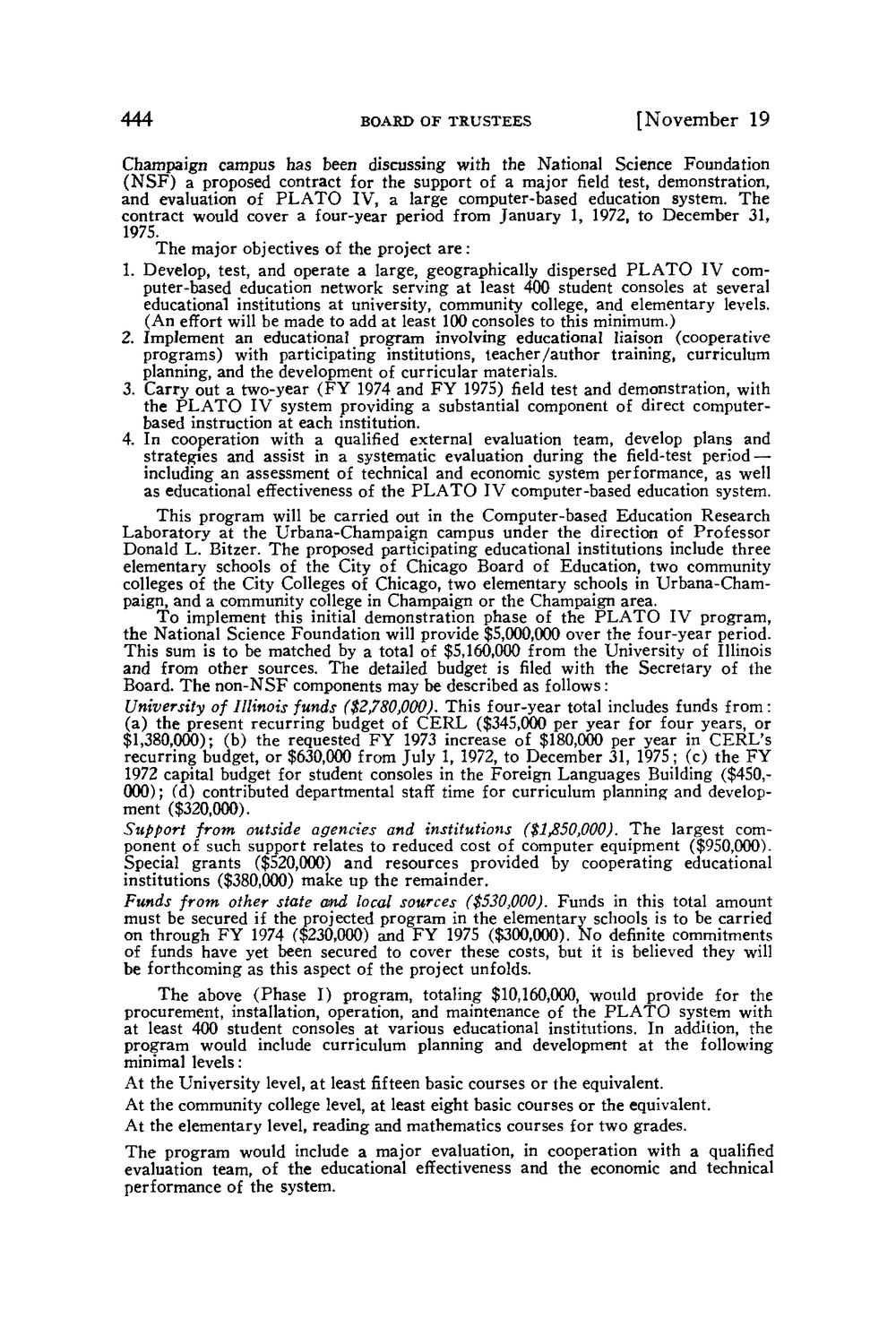| |
| |
Caption: Board of Trustees Minutes - 1972
This is a reduced-resolution page image for fast online browsing.

EXTRACTED TEXT FROM PAGE:
444 BOARD OF TRUSTEES [November 19 Champaign campus has been discussing with the National Science Foundation ( N S F ) a proposed contract for the support of a major field test, demonstration, and evaluation of P L A T O IV, a large computer-based education system. T h e contract would cover a four-year period from January 1, 1972, to December 31, 1975. The major objectives of the project a r e : 1. Develop, test, and operate a large, geographically dispersed P L A T O I V computer-based education network serving at least 400 student consoles at several educational institutions at university, community college, and elementary levels. (An effort will be made to add at least 100 consoles to this minimum.) 2. Implement an educational program involving educational liaison (cooperative programs) with participating institutions, teacher/author training, curriculum planning, and the development of curricular materials. 3. Carry out a two-year ( F Y 1974 and F Y 197S) field test and demonstration, with the P L A T O I V system providing a substantial component of direct computerbased instruction at each institution. 4. In cooperation with a qualified external evaluation team, develop plans and strategies and assist in a systematic evaluation during the field-test period — including an assessment of technical and economic system performance, as well as educational effectiveness of the P L A T O I V computer-based education system. This program will be carried out in the Computer-based Education Research Laboratory at the Urbana-Champaign campus under the direction of Professor Donald L. Bitzer. The proposed participating educational institutions include three elementary schools of the City of Chicago Board of Education, two community colleges of the City Colleges of Chicago, two elementary schools in Urbana-Champaign, and a community college in Champaign or the Champaign area. T o implement this initial demonstration phase of the P L A T O I V program, the National Science Foundation will provide $5,000,000 over the four-year period. This sum is to be matched by a total of $5,160,000 from the University of Illinois and from other sources. The detailed budget is filed with the Secretary of the Board. The n o n - N S F components may be described as follows: University of Illinois funds ($2/80,000). This four-year total includes funds from: (a) the present recurring budget of C E R L ($345,000 per year for four years, or $1,380,000); (b) the requested F Y 1973 increase of $180,000 per year in CERL's recurring budget, or $630,000 from July 1, 1972, to December 31, 1975; (c) the F Y 1972 capital budget for student consoles in the Foreign Languages Building ($450,000); (d) contributed departmental staff time for curriculum planning and development ($320,000). Support from outside agencies and institutions ($1£50,000). T h e largest component of such support relates to reduced cost of computer equipment ($950,000). Special grants ($520,000) and resources provided by cooperating educational institutions ($380,000) make up the remainder. Funds from other state and local sources ($530,000). Funds in this total amount must be secured if the projected program in the elementary schools is to be carried on through F Y 1974 ($230,000) and F Y 1975 ($300,000). No definite commitments of funds have yet been secured to cover these costs, but it is believed they will be forthcoming as this aspect of the project unfolds. The above (Phase I) program, totaling $10,160,000, would provide for the procurement, installation, operation, and maintenance of the P L A T O system with at least 400 student consoles at various educational institutions. In addition, the program would include curriculum planning and development at the following minimal levels: At the University level, at least fifteen basic courses or the equivalent. At the community college level, at least eight basic courses or the equivalent. At the elementary level, reading and mathematics courses for two grades. T h e program would include a major evaluation, in cooperation with a qualified evaluation team, of the educational effectiveness and the economic and technical performance of the system.
| |